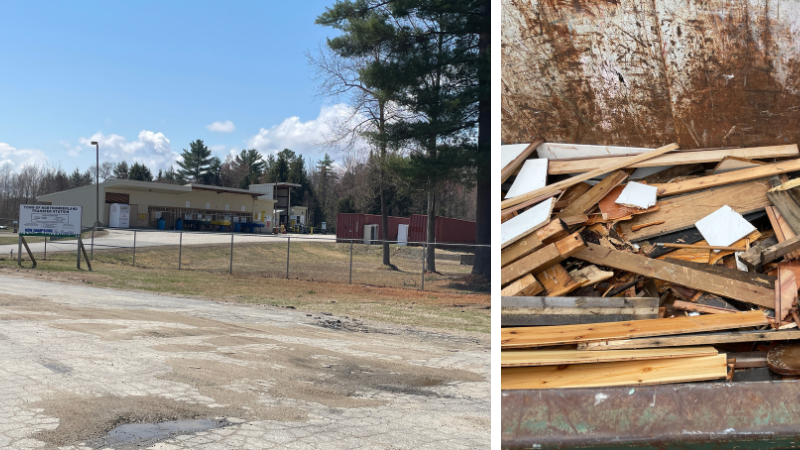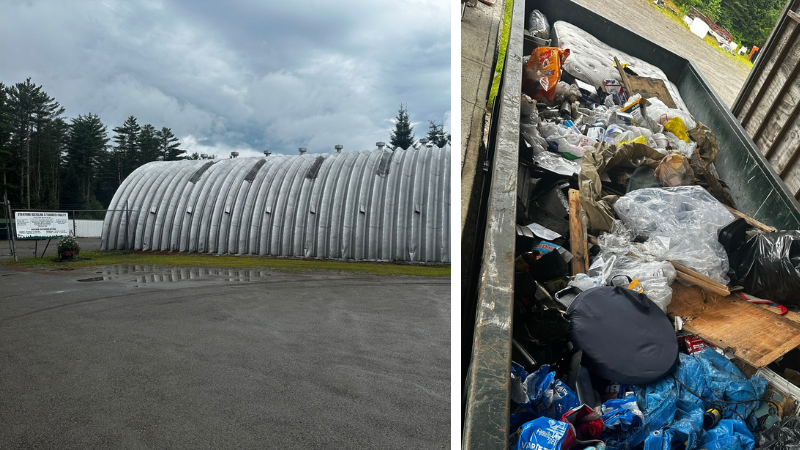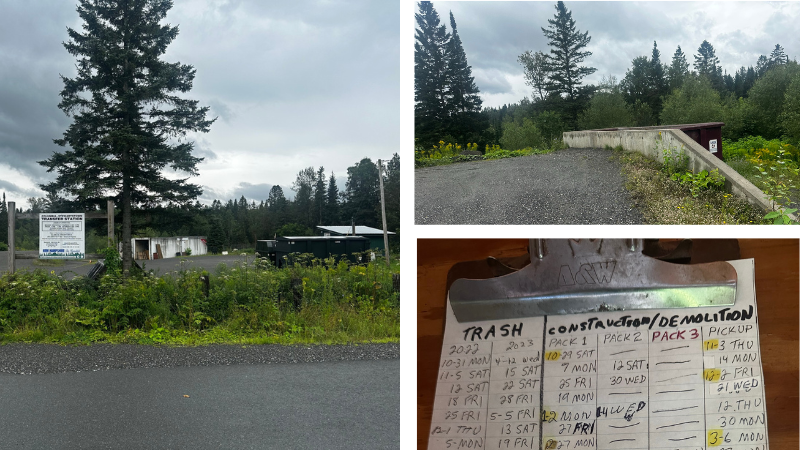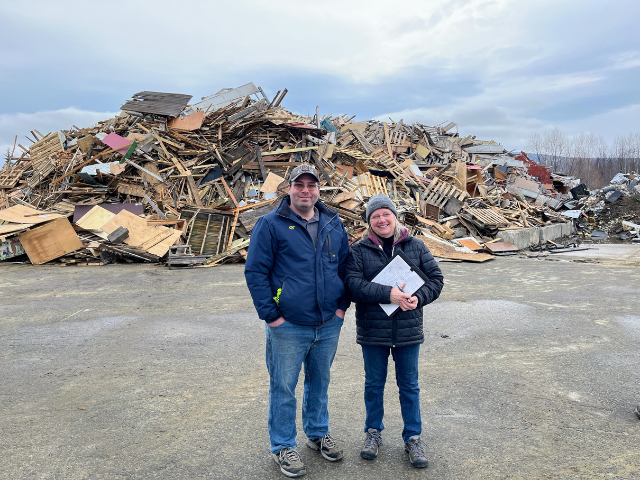Case Study: C&D Technical Assistance for 3 Coös County Facilities
Coös County Construction & Demolition (C&D) Debris Diversion Case Study
Northumberland, NH Transfer Station, Stratford, NH Transfer Station, and Coös County Transfer Station are three municipal transfer stations in Coös County, the northernmost county in New Hampshire.
The first two transfer stations serve the communities of Northumberland (population 2,126) and Stratford (population 662). Coös County Transfer Station serves the New Hampshire towns of Columbia and Stewartstown and the Vermont town of Lemington (total population 1,572). These communities have limited options to recycle their construction and demolition debris (C&D) and therefore largely landfill the material. In the spring and summer of 2023, the Northeast Resource Recovery Association (NRRA) conducted site visits to each transfer station to evaluate their C&D management practice and provide recommendations to both increase C&D diversion and reduce related costs and greenhouse gas emissions.
END USES & TIPPING FEES
While the transfer stations differ in some of their C&D and bulky waste management practices, all three send scrap metal to a scrap metal facility for recycling. All three transfer stations currently have relatively low tipping rates for disposing C&D (between $58 and $72 per ton compared to approximately $105 current market rate). Since the closest C&D recycling facility is a long distance away from each transfer station, recycling C&D is not cost effective.
DENSIFYING
All three transfer stations have local options for densifying their C&D, which saves money both on hauling costs and transportation emissions since they can pack more weight into each haul of C&D to the landfill.
HIGHLIGHTS
Northumberland has the most options for recycling and reuse of C&D. Wood is separated and sent to the Androscoggin Valley Regional Refuse Disposal District (AVRRDD) Transfer Station in Berlin, NH, for grinding to be used as landfill alternative daily cover. Asphalt, brick, and concrete (ABC) is separated, crushed, and used for town projects. All other C&D is sent to the Mt. Carberry Landfill. The Northumberland transfer station is next to the Highway Department, which allows for the town to easily and frequently crush the open top container of C&D to allow for more weight per container. They get an average of 8 tons per container. Because the Northumberland hauler is local, the haul rate is lower based on mileage. Residents put material directly into the C&D open top container, saving labor costs. The Northumberland facility is compact allowing for optimal operator oversight. Since Northumberland is part of the Androscoggin Valley Regional Refuse Disposal District (AVRRDD), the town is using the wood grinding program through the district. The wood is transported via open top and is ground at the district’s recycling center. The wood is used as alternative daily cover at the landfill. There are transportation costs, but no tipping fee with this option.
 Northumberland transfer station facility and wood separated from the C&D pile as part of the AVRRDD wood chipping program.
Northumberland transfer station facility and wood separated from the C&D pile as part of the AVRRDD wood chipping program.
The town of Stratford mixes C&D with both bulky waste and glass and sends it all to the Mt. Carberry Landfill. The Stratford transfer station currently hires a local vendor to compact their C&D open top container for $50 per visit. The vendor’s backhoe is stored at the facility, keeping the rate low. Compaction creates an average container tonnage of 5 to 8 tons. The C&D container is under a roof, which helps keep material dry and importantly, stops snow collection, which could add weight, freeze and make it harder to empty the container. Stratford facility operators separate as much metal as they can from the C&D container. They also separate non-ferrous metals, which have a higher value than light iron. The town currently has a good stockpile of aluminum (e.g. siding), stainless steel (e.g. sinks), wire (e.g. house wire and cords), and copper (e.g. plumbing and radiators).

Stratford Transfer Station facility and demolition in an open top container.
The Coös County transfer station is set up so that multiple towns and the county partner together to share resources. Resource sharing among towns can help lower individual municipal costs. The facility hires a local person to crush the open top container. The individual charges $150 per crush. The container is compacted as needed; during a 9-month span the facility averaged 1.7 compactions per container. Every container received one crush, 62% getting a second crush, and under 5% getting a third crush.

Coos County facility, an open top container for metal, and the crush list for C&D.
CHALLENGES
Similar challenges faced all three Coös County facilities. For example, there are no large reuse stores in the area, so residents are limited on their reuse options. Additionally, all three facilities combine bulky waste, such as furniture, into the same open top container with their C&D. This makes it difficult to calculate the true tonnage of construction and demolition debris. Finally, each facility is run by a very limited labor force.
There are a couple of challenges unique to the specific facilities as well. For instance, Stratford only has single phase power, making it difficult to purchase and run equipment. The Coös County Transfer Station is owned and operated by Coös County, but the buildings and equipment are owned by the individual towns. Each town has a role, which means making changes can be difficult, as multiple towns must give approval.
OPPORTUNITIES
NRRA recommends that the facilities promote the utilization of existing social media groups, such as Craigslist, the “free stuff” section of Facebook Marketplace, or the “North Country Market Post It Here” Facebook group to residents and facility customers. This would allow people to give away items instead of taking items to the facilities for disposal.
Northumberland is a potential future-location for a regional hub for asphalt, brick, and concrete (ABC). This could allow other communities to reuse their ABC locally instead of disposing of it, which would reduce haul fees and transportation emissions to landfill.
The town of Stratford could recycle or reuse their glass by purchasing a new glass crusher or sending glass to the Littleton, NH Glass Consolidation site through NRRA.
The Coös County transfer station could purchase or build a cover for the open top to keep snow and rain out of C&D. This would save the facility money, as the rain and snow can add weight to a container.
Both the Stratford and Coös Country facilities could investigate purchasing a backhoe to compact their materials as needed, rather than hiring out compaction to a local vendor.
NRRA recommends that all facilities direct residents to throw lighter materials such as plastic and Styrofoam in the Municipal Solid Waste (MSW). The MSW compactor has a better compaction rate than densifying material with a backhoe. This change would result in less hauls to the landfill, and therefore lower costs and lower greenhouse gas emissions thanks to reduced transportation.
If you have questions about these case studies, please reach out to the NRRA Member Services team at info@nrrarecycles.org or 603-736-4401.
This project has been funded wholly or in part by the United States Environmental Protection Agency under assistance agreement 00A01024 to Northeast Resource Recovery Association. The contents of this document do not necessarily reflect the views and policies of the EPA.
